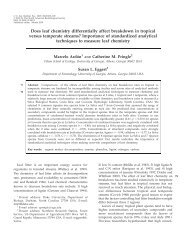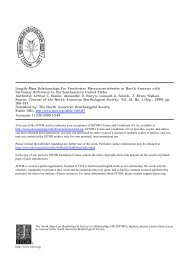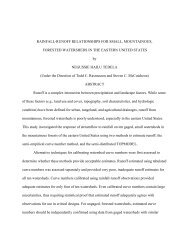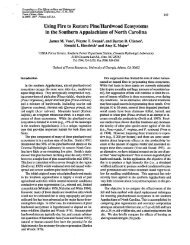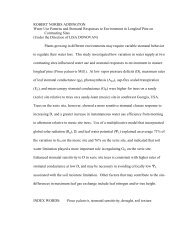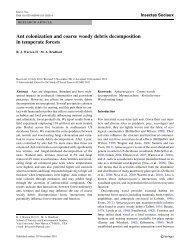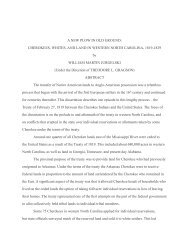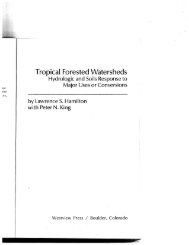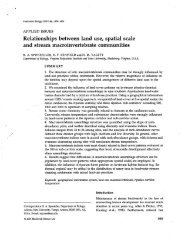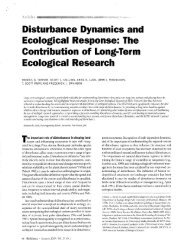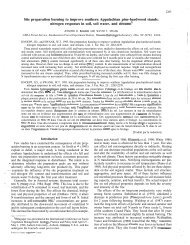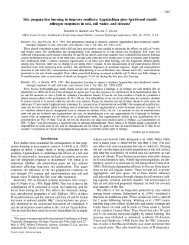biology join - Coweeta LTER - University of Georgia
biology join - Coweeta LTER - University of Georgia
biology join - Coweeta LTER - University of Georgia
You also want an ePaper? Increase the reach of your titles
YUMPU automatically turns print PDFs into web optimized ePapers that Google loves.
Articles<br />
depends on plant species. Elevated nitrogen mineralization<br />
contributes significantly to fluxes <strong>of</strong> greenhouse gases and<br />
to the cycling <strong>of</strong> nitrogen and carbon. In the mixed-grass<br />
prairie <strong>of</strong> North America, greater snowpack increased soil<br />
moisture by midsummer, which resulted in increased soil<br />
respiration (Chimner and Welker 2005) and increased plant<br />
invasions (Blumenthal et al. 2008).<br />
But most <strong>of</strong> the attention to the biogeochemical consequences<br />
<strong>of</strong> cryosphere loss has been focused on the potential<br />
for changes in carbon storage and release. Arctic permafrost<br />
contains twice the CO 2 found in the atmosphere, which<br />
dramatically demonstrates the potential for altering the<br />
climate as further warming occurs. Site-specific information<br />
can provide some indication as to the future release<br />
rate <strong>of</strong> carbon from thawing permafrost. A recent group<br />
<strong>of</strong> studies was focused on an upland thermokarst site near<br />
Denali National Park in Alaska, where changes in plant and<br />
soil processes were studied as a function <strong>of</strong> time since the<br />
thermokarst disturbance was initiated. The studies showed<br />
that increased permafrost thaw and ground-surface subsidence<br />
increased net and gross primary productivity as<br />
plant growth was stimulated by a thaw (Vogel et al. 2010).<br />
Plant species composition changed along with changes in<br />
plant growth rates as graminoid-dominated moist acidic<br />
tundra shifted to shrub-dominated tundra with increased<br />
rates <strong>of</strong> thawing. The increased carbon uptake by plants<br />
initially <strong>of</strong>fset the greater ecosystem respiration, such that<br />
this thermokarst was a net sink <strong>of</strong> carbon 15 years after the<br />
initiation <strong>of</strong> the thaw, even though decomposition <strong>of</strong> older<br />
carbon deep in the soil was already taking place (Schuur<br />
et al. 2009). Over more decades <strong>of</strong> thaw, plant growth rates<br />
remained high, but increased old soil carbon losses eventually<br />
<strong>of</strong>fset the greater carbon uptake, and this thermokarst<br />
became a net source <strong>of</strong> carbon to the atmosphere.<br />
In a contrasting study <strong>of</strong> lowland thermokarst in three<br />
Canadian peatlands, the carbon accumulation in surface<br />
soil organic matter was higher in unfrozen bogs and in<br />
areas where permafrost had degraded than in areas where<br />
permafrost was intact (Turetsky et al. 2007). This growth<br />
in surface soil carbon accumulation was consistent with<br />
the Alaskan upland study, but the equivalent net ecosystem<br />
carbon exchange measurements were not available to<br />
determine whether the thawed permafrost peat ecosystems<br />
were overall net sources or sinks <strong>of</strong> carbon. Permafrost<br />
thaw in this lowland system promoted the release <strong>of</strong> methane<br />
(CH 4 ) because waterlogged conditions predominated<br />
in Sphagnum moss lawns that replaced the feather moss<br />
(Hylocomium splendens) and black spruce (Picea mariana)<br />
forest in locations where permafrost degraded. This CH 4<br />
release was hypothesized to potentially <strong>of</strong>fset the observed<br />
surface soil carbon accumulation for at least for 70 years,<br />
until plant and ecosystem succession in the moss lawn created<br />
conditions more like those in the unfrozen bogs, which<br />
stored surface soil carbon but released only small amounts<br />
<strong>of</strong> CH 4 . The release <strong>of</strong> CH 4 is a common pathway <strong>of</strong> carbon<br />
loss in lowland thermokarst, where drainage is restricted<br />
( Myers-Smith et al. 2007), and CH 4 has 25 times greater heattrapping<br />
capacity than CO 2 on a century timescale. However,<br />
decreased total carbon emissions in anaerobic systems can<br />
partially <strong>of</strong>fset the increased radiative forcing <strong>of</strong> CH 4 release,<br />
which possibly makes the net radiative forcing <strong>of</strong> increased<br />
carbon losses in lowland and upland thermokarst more<br />
similar than what the difference in heat-trapping capacity<br />
between CO 2 and CH 4 would initially suggest.<br />
The oceanic sink for anthropogenic CO 2 is large and<br />
lessens the potential greenhouse effect by limiting CO 2<br />
accumulation in the atmosphere. The current (2009) net<br />
annual carbon uptake by the ocean is 2.3 ± 0.4 petagrams<br />
(Pg) <strong>of</strong> carbon per year, compared to 2.4 Pg <strong>of</strong> carbon<br />
per year for land, but the land uptake is partially <strong>of</strong>fset by<br />
the 1.1 ± 0.7 Pg <strong>of</strong> carbon per year in releases caused by<br />
deforestation (Le Quéré et al. 2009). As the ocean warms and<br />
its inventory <strong>of</strong> CO 2 increases, the oceanic sink is expected<br />
to weaken. Oceanic CO 2 uptake is governed by gas exchange<br />
across the air–sea interface, so the regional allocation <strong>of</strong><br />
CO 2 uptake is primarily a function <strong>of</strong> the area <strong>of</strong> sea surface<br />
involved. This fraction has been predicted to increase as ice<br />
melts and productivity increases, which will expose new<br />
ocean areas to solar irradiance (Peck et al. 2010). The Arctic<br />
Ocean constitutes just 3% <strong>of</strong> the total ocean area and is<br />
mostly covered by sea ice, which blocks gas exchange, but it<br />
accounts for 5%–14% <strong>of</strong> the total ocean CO 2 uptake. New<br />
observations suggest, however, that the recent dramatic loss<br />
<strong>of</strong> sea ice has been accompanied by decreased rather than<br />
increased CO 2 uptake (Cai et al. 2010), which is counter to<br />
current understanding and predictions. The rapid, diverse,<br />
and complex changes wrought by cryosphere loss constitute<br />
a major scientific challenge that demands new large-scale<br />
observing systems on land and in the ocean to provide new<br />
observational infrastructure as a resource for coordinated<br />
experimental studies performed by the <strong>LTER</strong> Network and<br />
other scientists.<br />
Effects on humans from the loss <strong>of</strong> snow and ice<br />
Cryosphere loss will result in far-reaching social, economic,<br />
and geopolitical impacts, but a detailed treatment<br />
is beyond the scope <strong>of</strong> this synthesis. Most attention has<br />
been devoted to the impacts associated with a loss <strong>of</strong> snow<br />
cover, glacier melting, and sea-level rise, which are treated<br />
elsewhere (Kundzewicz et al. 2007). Thawing permafrost<br />
will also have important social consequences, because it can<br />
destabilize engineered structures and can cause destructive<br />
slides, flows, and slumps. Changes in snow cover can<br />
have important consequences for humans and may affect<br />
many diverse activities, including agriculture, recreation,<br />
tourism, engineering, commerce, and energy production.<br />
For example, the New Hampshire ski industry has abandoned<br />
low-elevation ski areas in the southern part <strong>of</strong> the<br />
state since the 1970s, in part because <strong>of</strong> climate warming,<br />
in favor <strong>of</strong> ski areas at higher elevations in the north<br />
(Hamilton et al. 2003). Skiing contributes about $1 billion<br />
annually to the economy <strong>of</strong> Utah, but recent climate change<br />
412 BioScience • April 2012 / Vol. 62 No. 4 www.biosciencemag.org



